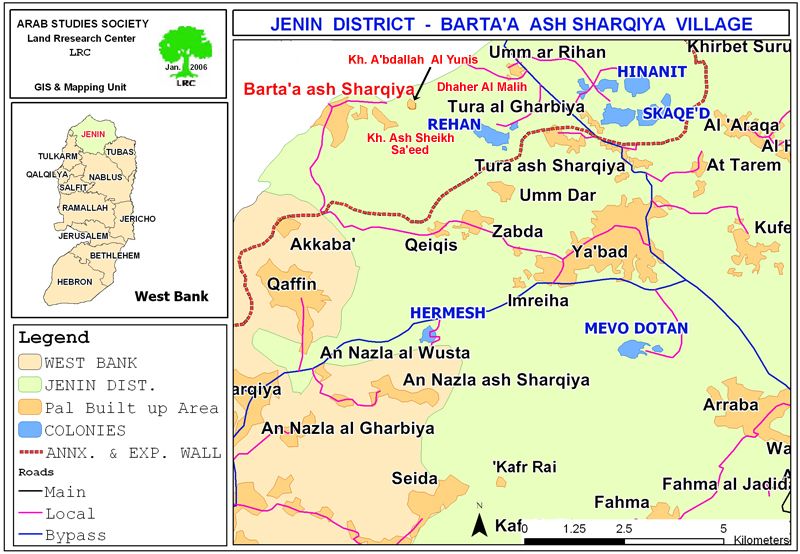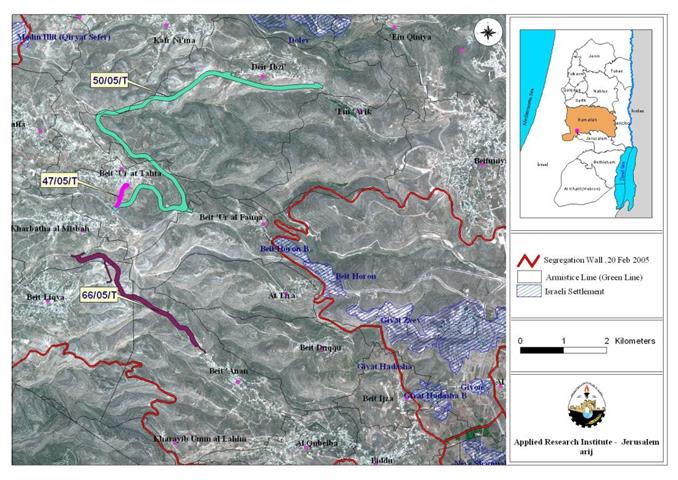Location, population and area
Barta'a Ash Sharqiyeh (East Barta'a) is a border village located to the south west of Jenin city in Jenin governorate. It has the total population of 3000 and a total surface area of 6363 dunums of which 805 dunums are built up area. See Map 1

Map 1: Location of Barta'a Ash Sharqiyeh and its Wall enclave)
Map prepared by LRC
Barta'a Ash Sharqiyeh and the occupation
Since 1948, Barta'a Ash Sharqiyeh has been loosing much of its lands and resources to the Israeli occupation. 70 % of its original lands were lost in 1948 and expropriated to Israel while hundreds of its people were dismissed eastward in the West Bank proper and started a new village under the name of Barta'a Ash Sharqiyeh. As a result of the occupation of 1948 the village was divided into two parts, the west Barta'a (Barta'a Al Gharbiya) and east Barta'a (Barta'a Ash Sharqiyeh) separated by the truce lien (armistice line). After the occupation of 1967, the village became under successive aggressions and violations including the following:
1. Continuous and organized campaigns of arrest against its people;
2. Deprivation from basic infrastructure and public services at the top of which is deprivation from having a water network and connection to regional water networks;
3. Prevention of the village local council from digging alternative water wells;
4. Denial from having building permissions where 90 % of houses and structures lack proper licensing because of the Israeli intentions to free the area of Palestinians.
Barta'a Ash Sharqiyeh and the Wall
In 1994, the construction of the Annexation and Expansion Wall was completed leading to the total separation of Barta'a Ash Sharqiyeh and its immediate environs of Khirbet Ash Sheik Sa'ad, Khirbet Abdallah Yunis, Dhaher Al Maleh and Um Ar Rihan. These five villages with a total population of 4300 inhabitants were confined to a closed canton behind the Wall. The only way to move in and out of this canton into other parts of the West Bank is through the means of two Wall gates passable only by having valid permits from the Israeli military.
As a result of this racist and aggressive Israeli policy, the five separated villages are severely suffering from the lack of services and they are economically and socially destroyed.
New demolition campaign
To add to the suffering of local people in this enclave, the Israeli occupation authorities carried out a new demolition campaign during last December against houses, commercial and agricultural installations in the village under the pretext of un-licensing. The destroyed installations are only 50 meters from the green line (armistice line).
The following is a list of destroyed structures:
1. A 550 m² commercial and agricultural compound owned by Mr. Ramzi Ahamd Kabha consisted of 13 green houses;
2. A 145 m² under construction house owned by Mr. Zaki Falah Kabha;
3. A 100 m² inhabited house owned by Mr. Khalil Ibrahim Ammar;
4. A 95 m² under construction house owned by Mr. Munzir Nazmi Kabha;
5. A two- floor 160 m² commercial store owned by Mr. Sa'id Daood Kabha.
It is worth mentioning that the demolition orders were issued eight months before actual demolition. During that period petitions were presented to the Israeli so- called high court of justice, but, to no avail.
Despite the natural growth's needs in this enclave, the Israeli occupation authorities give no building permits to Palestinians whatsoever. The ferocity of the Israeli denial is very obvious. On December 7th, 2005, a convoy of Israeli armored personnel carriers, military jeeps and bulldozers moved towards the targeted structures in Barta'a Ash Sharqiyeh, giving owners only 15 minutes to evacuate contents before knocking down all the structures under the sight of owners and the village people.
In an interview with LRC field worker, owner Khalil Ibrahin Ammar said the following: 'I spent all what I had invested in building my house. Even, I was obliged to sell the dowry of my wife. The Israelis have destroyed any single hope for peace to me and my family. We have done nothing worth destroying our house except the fact that we are Palestinians'.
Mr. Ramzi Kabha was no better. He had lost 13 green houses which served as the only source of living for him and his large extended family.
Prepared by
The Land Research Center
LRC











